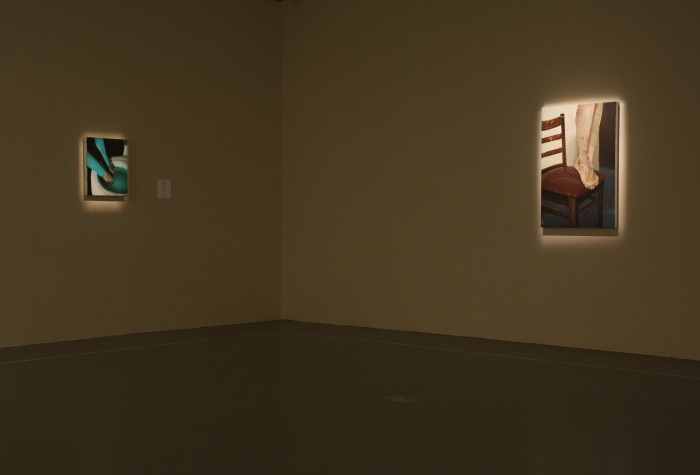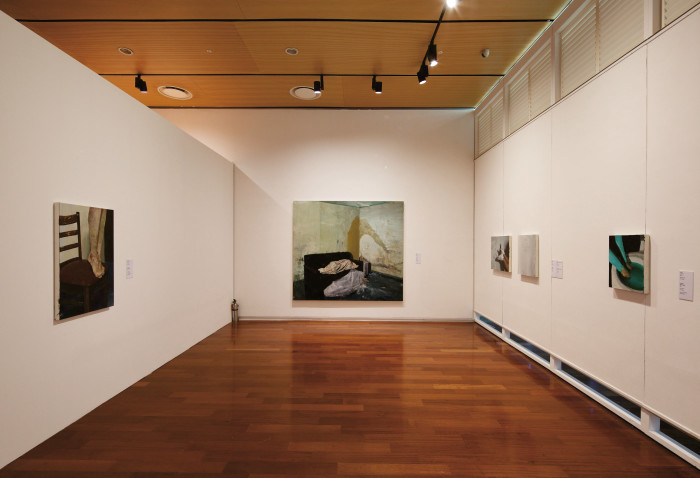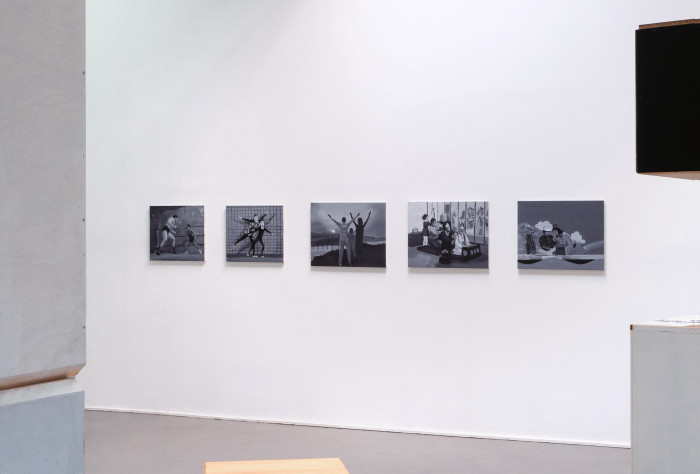경기문화재단
Ahn Jisan, Semi-basement The Incident of a Missing Face and Afterward
Gyeonggi Museum of Modern art
This catalogue is published in conjunction with 2017-2018 Korea–Germany Contemporary Art Exchange Exhibition Irony & Idealism. It documents all exhibitions and artworks at 3 venues in Korea and Germany-Gyeonggi Museum of Modern Art, KF Gallery and Kunsthalle Münster-from September 2017 until September 2018.
|
Lee Jung Hwa Screenwriter

Jisan Ahn’s Semi-basement is a painting that depicts a child scribbling on the wall in a semi-basement space. The child in the painting is standing on a sack, stretching her arm to draw (or write) something on the wall. That the person on the sack is not an adult but a child makes us feel uneasy and nervous. It is convincing to think that the child will fall to the ground before she completes her scribble. This is because we are accustomed to the stereotypical narrative where one unfortunately fails right before realizing her goal. Is it just another case of pessimism? Isn’t the repetition of reality another name of banal pessimism? I calm my anxious mind and come close to the child in the painting. However, the child is without a face.
The body without a face is not something unfamiliar. It is not unfamiliar, at least in art, as seen from sculptures in the Greco-Roman period beheaded by invaders to faces in René Magritte’s paintings that are wrapped in cloth and disfigured faces in Francis Bacon’s paintings. The face is deleted and concealed not because they are not of importance but because they are too important. The reason the face is of such importance is that it provides ‘identity’ to individuals. If there are thousand people, there are thousand different faces. The face is also a ‘production site of expressions’ that represents emotions. However, it is ambiguous and calculative. On the other hand, facial expressions are obvious and instinctive. And this is why faces are shot in closeup in movies when the emotion of characters shall be delivered in a clear manner.
The child in Semi-basement, however, is without a face. But Semi-basement is not the only work that features the body without a face. The theme repeatedly appears in other works by the artist. In A Life on the Ocean Wave, Bas Jan Ader’s face cannot be seen since he covers his face with his hands; figures depicted in Nap 2 are laid down with cloth and bubble wrap covering them, making it impossible not only to see their faces but also confirm if they are humans; and the faces of those that appear in Washing Hands, Hand Soaking, Stand on tiptoe, and Untitled even exist outside the frame of the canvas.

By this point, one cannot but suspect if the artist intentionally deletes and hides faces in his paintings. And just recently, I happened to hear from the artist the reason behind the erasure. It is no less than embarrassing regarding my position as a writer. If I compare the occasion with a narrative, the ‘incident of a missing face’ of a child appearing in Semi-basement has become a flat story where the criminal motive is exposed in addition to the identity of a culprit. The most regrettable part is that the incident cannot follow the familiar narrative path where the full account of the incident is unstoppably revealed at the end. Given the situation, this essay cannot but walk through the path of an unfamiliar narrative. It is not to narrate “Why did the artist not draw the face?” but to describe ‘the effect of the artist’s decision not to draw faces in his paintings.’
If one considers Semi-basement as a scene in a movie, a full-shot of the scribbling child and a closeup of one’s face are shots that must be filmed. Viewers will comprehend the situation of the character through the full-shot while the close-up delivers the character’s emotions. But the problem is that the emotions and the situation are not separate but connected. The situation where the character is situated leads the viewers to guess the character’s emotions, and the emotions draw the situation to the inside of the story. To understand what is unfolding in front of our eyes more accurately, we have to acknowledge both the emotions and the situation. And the ‘accurate understanding’ leads us to the final destination that is ‘sympathy.’ It is the same with how dominoes work. It starts with the situation and emotions of a given character and ends with sympathy. Thus, we – who do not know the emotions and situation of the child appearing in Semi-basement because of the absence of one’s face – cannot sympathize with one.

Since we cannot sympathize with the character, we feel stuck. However, it is different from the feeling of being stuck that an art enthusiast experiences in front of a difficult work of art. Only few people desire to understand artworks with precision. Whereas the feeling of being stuck that we sense in the face of Semi-basement comes from our imprecise comprehension of what is going on in front of our eyes. If the desire to understand Semi-basement as a complete painting is ‘selective desire of the few,’ the desire to comprehend the painting as a scene is ‘universal desire of the many.’ And I belong to the side of the many. Hence, I prioritize the realization of the universal desire of the many. To realize this, we need to imagine the child without a face that appears in Semi-basement.
The best way to imagine how others live is to become them. You can be assured of this statement since a vampire, who is too old even to remember her age, said it. In the movie Let the Right One In, Eli, a vampire, tells Oscar, an ordinary boy that cannot understand what it is like to live as a vampire, “Be me, for a little while.” Oscar closes his eyes and becomes Eli. Here, to become Eli is to live through her time. And it is an action that is exactly the same as constructing a narrative where others are the protagonist. In order to have an experience of becoming the child in Semi-basement, I created a story about her. The story is as follows.
# A place in semi-basement.
Day time. Hurriedly ran into the place, Sayoon(girl, nine years old) looks around everywhere with her big eyes filled with terror, then runs toward a sack leaning on the corner of the wall. The sack is full of the kind of sand that is used at construction sites. Sayoon starts climbing up the sack. The bridge of Sayoon’s nose is beaded with sweat, her cheeks blush, and her short hair tangled up. Sayoon, successfully climbing up the sack after a few failed attempts, takes a pencil stub from her pocket and starts drawing a face of a man on the wall. Although the drawing is done by unskilled hands of a child, the completed picture is a fairly fine montage depicting all the features of the man’s face. Under the face of the man, Sayoon writes, “This man is the culprit.” But at the moment.
(E)
Click-clack-click-clack-
(The sound of footsteps coming down the stairs)
Surprised by the sound, Sayoon turns her
head to the stairs. At that moment, her body
staggers and falls to the floor.
The face of the child, who even has a name Sayoon, is specific enough to draw its image. Now that the face is completed, it is a matter of time to reach sympathy. However, it feels heavy to see the child’s face in completion. This is because everything about the child, including her age, gender, looks, and character, is determined at the very moment when the depiction of her face is completed. Drawing one’s face is no less different from declaring to someone, “You are such a person.” And the problem is that most such declarations are violent and far from the truth regardless of their being positive or negative.” The short hair will confirm Sayoon as a boyish child, and her frightened eyes will easily be substituted with a sentence, “Sayoon is timid.”
After making a constant effort to depict the face,
I ironically discovered the benefit that Semi-basement
has acquired thanks to the absence of the face.
Since there is no face in the painting, the child can
avoid affirmations, and the situation of the child is
also put under diverse possibilities. Of course, at the
moment when a story about the child is created, her
face will be completed once again. However, since
it shall not be the one forced by the artist but created
by each of us, it is always possible to change. At
least, it does not remain unchanged forever.
Returning to where this essay began, I stand in front of Semi-basement. I still cannot exactly comprehend what is unfolding in front of my eyes, I do not feel stuck anymore. The child can be a girl, a boy, angry, frightened, or amused. The painting can also be depicting a scene from the past, the present, or the future. Within these infinite possibilities, it is even impossible to imagine the scope of possibilities about what stories will be created. What is obvious at least is that a thousand people will create a thousand stories when they see semi-basement. This is because these thousand storytellers all possess different faces.

<ggc의 모든 콘텐츠는 저작권법의 보호를 받습니다.>
세부정보
IRONY & IDEALISM
Publisher/ Sul Wonki
Chief Editor/ Choi Eunju
First Edition/ July 31. 2018
Published by/ Gyeonggi Museum of Modern Art
List of Artists/ Ahn Jisan, Bae Young-whan, Björn Dahlem, Gimhongsok, Hwayeon Nam, Michael van Ofen, Manfred Pernice, Yoon Jongsuk